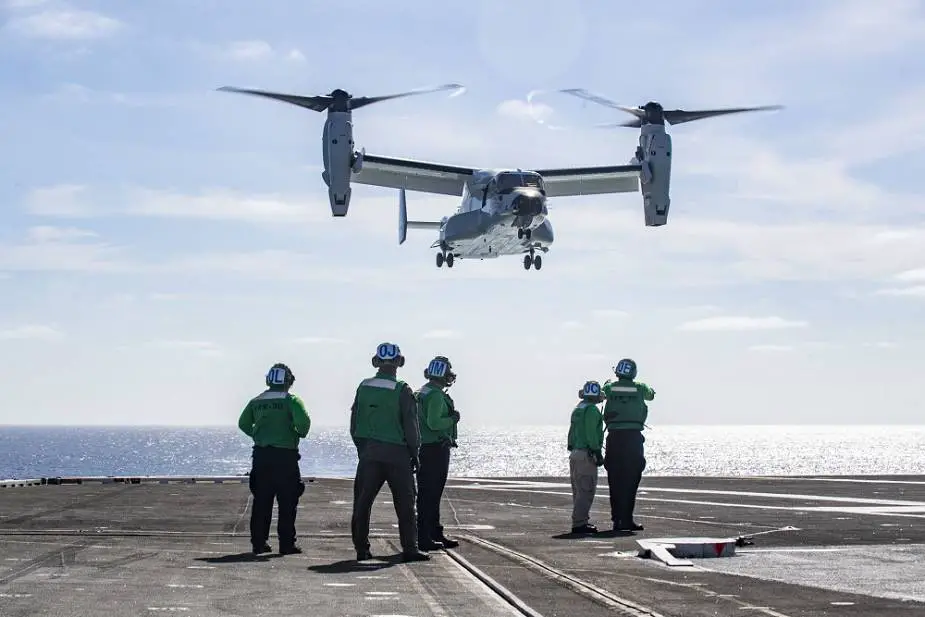According to information released by the U.S. Department of Defense on December 4, 2020, a CMV-22B Osprey tiltrotor aircraft has conducted first landings, take-offs, and refueling on the flight deck of USS Carl Vinson (CVN 70) Nimitz-class nuclear-powered aircraft carrier. The CMV-22B is the U.S. Navy version of the Osprey, a multi-engine, dual-piloted, self-deployable, medium-lift, vertical takeoff and landing (VTOL) tilt-rotor aircraft.
Follow Navy Recognition on Google News at this link
 A CMV-22B Osprey from the “Titans” of Fleet Logistics Multi-Mission Squadron (VRM) 30 approaches the flight deck of Nimitz-class nuclear aircraft carrier USS Carl Vinson CVN 70. (Picture source U.S. Navy)
A CMV-22B Osprey from the “Titans” of Fleet Logistics Multi-Mission Squadron (VRM) 30 approaches the flight deck of Nimitz-class nuclear aircraft carrier USS Carl Vinson CVN 70. (Picture source U.S. Navy)
In order to support fifth-generation aircraft, Vinson received major upgrades during a 17-month maintenance availability, making Vinson the first aircraft carrier equipped to support both the F-35C Lightning II and the CMV-22B Osprey. As the Carrier Onboard Delivery (COD) aircraft, the CMV-22 will transport personnel, mail, supplies, and high-priority cargo from shore bases to aircraft carriers at sea.
The first landings, take-offs, and refueling of the CMV-22B were carried out in collaboration with the Nimitz-class nuclear aircraft carrier USS Carl Vinson (CVN 70). This evolution marked the first time the Navy’s CMV-22B Ospreys have landed on a carrier. Vinson is currently underway conducting routine maritime operations.
The CMV-22B Osprey is a variant of the MV-22B and is the replacement for the C-2A Greyhound for the Carrier Onboard Delivery (COD) mission. The Osprey is a tiltrotor V/STOL aircraft that can take-off and land as a helicopter but transit as a turboprop aircraft. Compared to the C-2A, the CMV-22B offers increased operational range – capable of transporting cargo and passengers as far as 1,150 nautical miles, increased survivability, enhanced beyond-line-of-sight communications, greater cargo capacity, and faster cargo loading/unloading.
The CMV-22B will deliver lethality to the fleet, and enable the carrier strike group to achieve dominance across the air, land, and sea through the provision of high priority cargo and personnel from shore bases to aircraft carriers at sea. Additionally, the increased flexibility and capabilities of the CMV-22B will further expand the carrier strike group’s influence and agility, broadening its ability to meet a wide array of operational tasking.
The USS Carl Vinson (CVN-70) is the United States Navy's third Nimitz-class supercarrier. The ship was launched in 1980, undertook her maiden voyage in 1983, and underwent refueling and overhaul between 2005 and 2009. In September 2020, it was announced that the USS Carl Vinson aircraft carrier has finalized its 17 months of maintenance and upgrades at Puget Sound Naval Shipyard and Intermediate Maintenance Facility in Bremerton, Washington, including complete restoration and system retrofit to accommodate F-35C Lightning II Joint Strike Fighter mission capabilities.
In September 2020, the U.S. Navy USS Carl Vinson (CVN 70) Nimitz-class aircraft carrier successfully has completed several certifications, including flight deck certification (FDC) and carrier air traffic control center (CATCC) certification, after nearly a week of flight deck operations designed to ready the carrier for future operations. The underway also marked the first time that Carrier Air Wing (CVW) 2 and Vinson, both part of Carrier Strike Group (CSG) 1, fully integrated and operated together since the addition of the F-35C Lightning II.
The USS Carl Vinson can carry more than 65 fixed and rotary-wing aircraft and can travel more than 5,000 nautical miles in less than seven days in support of national tasking.



